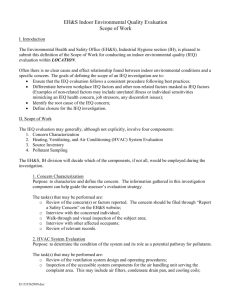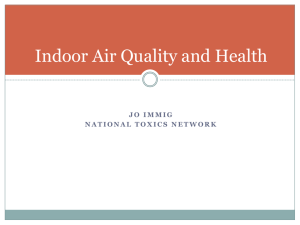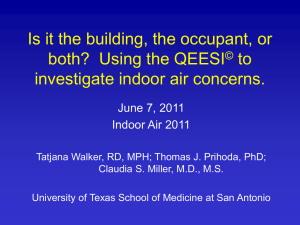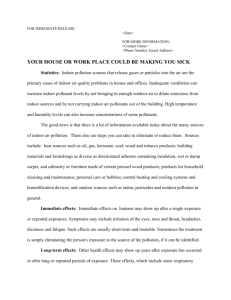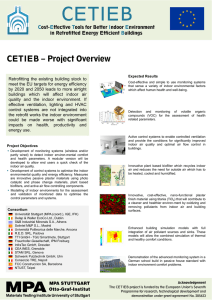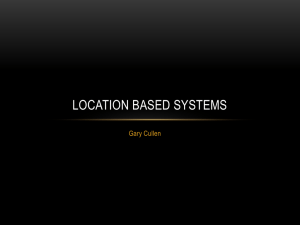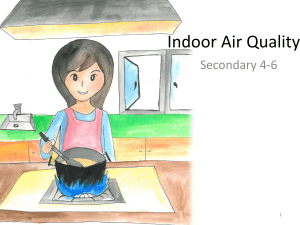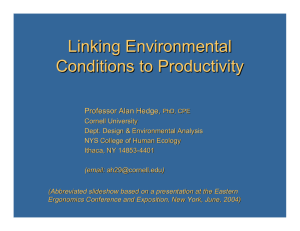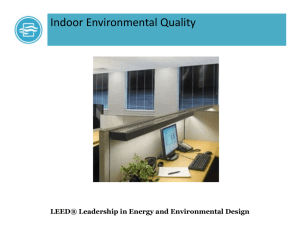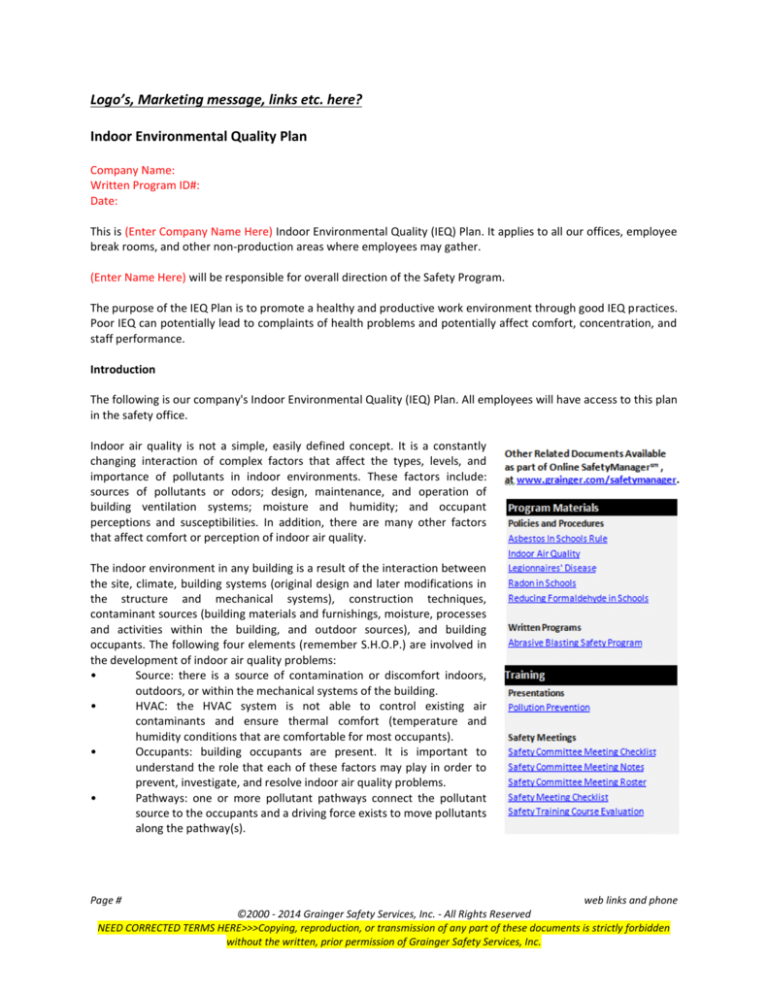
Logo’s, Marketing message, links etc. here?
Indoor Environmental Quality Plan
Company Name:
Written Program ID#:
Date:
This is (Enter Company Name Here) Indoor Environmental Quality (IEQ) Plan. It applies to all our offices, employee
break rooms, and other non-production areas where employees may gather.
(Enter Name Here) will be responsible for overall direction of the Safety Program.
The purpose of the IEQ Plan is to promote a healthy and productive work environment through good IEQ practices.
Poor IEQ can potentially lead to complaints of health problems and potentially affect comfort, concentration, and
staff performance.
Introduction
The following is our company's Indoor Environmental Quality (IEQ) Plan. All employees will have access to this plan
in the safety office.
Indoor air quality is not a simple, easily defined concept. It is a constantly
changing interaction of complex factors that affect the types, levels, and
importance of pollutants in indoor environments. These factors include:
sources of pollutants or odors; design, maintenance, and operation of
building ventilation systems; moisture and humidity; and occupant
perceptions and susceptibilities. In addition, there are many other factors
that affect comfort or perception of indoor air quality.
The indoor environment in any building is a result of the interaction between
the site, climate, building systems (original design and later modifications in
the structure and mechanical systems), construction techniques,
contaminant sources (building materials and furnishings, moisture, processes
and activities within the building, and outdoor sources), and building
occupants. The following four elements (remember S.H.O.P.) are involved in
the development of indoor air quality problems:
•
Source: there is a source of contamination or discomfort indoors,
outdoors, or within the mechanical systems of the building.
•
HVAC: the HVAC system is not able to control existing air
contaminants and ensure thermal comfort (temperature and
humidity conditions that are comfortable for most occupants).
•
Occupants: building occupants are present. It is important to
understand the role that each of these factors may play in order to
prevent, investigate, and resolve indoor air quality problems.
•
Pathways: one or more pollutant pathways connect the pollutant
source to the occupants and a driving force exists to move pollutants
along the pathway(s).
Page #
web links and phone
©2000 - 2014 Grainger Safety Services, Inc. - All Rights Reserved
NEED CORRECTED TERMS HERE>>>Copying, reproduction, or transmission of any part of these documents is strictly forbidden
without the written, prior permission of Grainger Safety Services, Inc.
IEQ Awareness
Two types of IEQ problems can arise in buildings. One is Sick Building Syndrome (SBS) and the other is Building
Related Illness. Sick Building Syndrome complaints are often: subjective (not measurable), non-specific in nature,
and associated with periods of occupancy. The causative agent(s) are difficult to find and medically diagnose. The
symptoms may include subjective reports of headache, nausea, fatigue, eye irritation, and respiratory irritation.
The symptoms often disappear when the employee leaves the workplace.
The other situation that occurs is Building Related Illness (BRI). This differs from Sick Building Syndrome in that it is
a physical reaction to an identifiable contaminant found to be prevalent in the indoor environment. BRI can be
diagnosed by a physician and a causative agent can be found in the work environment. Examples of Building
Related Illness are carbon monoxide poisoning and Legionnaires Disease.
Building managers need to treat IEQ complaints seriously and deal with them promptly. These situations are often
difficult to diagnose and solve. Quick action will help prevent other occupants throughout the building from
thinking they might have SBS when they're really experiencing some other form of stress, such as being over-tired.
All of the occupants of a building can have an influence on indoor environmental quality. Everyday activities like
heating food in a microwave, wearing perfume, and using the photocopier can generate odors and pollutants. By
being aware of indoor air issues, you can help prevent problems. Below is a table that lists typical sources of indoor
pollutants.
OUTDOOR SOURCES
BUILDING EQUIPMENT
Polluted Outdoor Air:
HVAC Equipment:
•
•
•
Pollen, dust, mold
spores
Industrial emissions
Vehicle and nonroad
engine emissions (cars,
buses, trucks, lawn,
and garden equipment)
•
•
•
Mold growth in drip
pans, ductwork, coils,
and humidifiers
Improper venting of
combustion products
Dust or debris in
ductwork
COMPONENTS/
FURNISHINGS
Components:
•
•
•
•
Nearby Sources:
•
•
•
Loading docks
Odors from dumpsters
Unsanitary debris or
building exhausts near
outdoor air intake
Page #
Mold growth on or in
soiled or waterdamaged materials
Dry drain traps that
allow the passage of
sewer gas
Materials containing
VOCs, inorganic
compounds, or
damaged asbestos
Materials that produce
particles (dust)
OTHER
POTENTIAL
INDOOR SOURCES
•
Science laboratory
supplies
•
Vocational art supplies
•
Copy/print areas
•
Food prep areas
•
Smoking lounges
•
Cleaning materials
•
Emissions from trash
•
Pesticides
•
Odors and VOCs from
paint, caulk, adhesives
•
Occupants with
communicable diseases
•
Dry-erase markers and
similar pens
•
Insects and other pest
•
Personal care products
•
Stored gasoline and
lawn and garden
equipment
Other Equipment:
•
•
Emissions from office
equipment (volatile
organic compounds
VOCs, ozone)
Emissions from shop,
lab, and cleaning
Furnishings:
•
Emissions from new
furnishings and
floorings
web links and phone
©2000 - 2014 Grainger Safety Services, Inc. - All Rights Reserved
NEED CORRECTED TERMS HERE>>>Copying, reproduction, or transmission of any part of these documents is strictly forbidden
without the written, prior permission of Grainger Safety Services, Inc.
Underground Sources:
•
•
•
•
Radon
Pesticides
Leakage from
underground storage
tanks
equipment
Mold growth on or in
soiled or waterdamaged furnishings
•
•
•
Insects and other pests
Personal care products
Stored gasoline and
lawn and garden
equipment
What the Office Manager Can Do
(Enter Name Here) is responsible for office policies and relations with the property owner who is often in a
position to directly impact indoor air quality in the space. The office manager should follow some office procedures
in dealing with the building management.
Suggestions to improve Indoor Air Quality:
1.
Maintain a good working relationship with building management on indoor environmental issues (IEQ).
2.
Follow your internal guidelines to ensure that building management is involved in all indoor air quality
issues. Be as knowledgeable as possible when dealing with building management on indoor air issues.
3.
Make sure air supply vents and return grilles are not blocked by furniture or office equipment. Computers
and other heat-producing equipment placed near or under an HVAC sensor device system can trigger
cooling, even if the actual temperature of occupants is cool. Place such equipment away from HVAC
sensors to avoid this kind of situation.
4.
Coordinate with building management in instances when responsibility for design, operation and
maintenance of the HVAC system is shared. Sometimes the portion of the HVAC system servicing a leased
space is the responsibility of the tenant. In such cases, work closely with building management to ensure
that all parts of the building receive optimal service from the system. Ensure that filters in window air
conditioners and perimeter heating and cooling units are changed frequently.
Avoid Products that Cause IEQ Problems
Many products used in offices, like solvents, adhesives, cleaners, and pesticides can give off pollutants and odors,
as can office equipment such as copiers, printers, and fax machines. Look at the project labels and choose those
that state "Low Volatile Organic Compounds" (VOCs). If any of these items are used in the office environment, all
label directions and cautions should be closely followed.
Establish Pest Control Practices
Pesticides can contribute to poor indoor air quality and can cause serious health effects when used improperly.
Unacceptable levels of pest activity and damage should be prevented by the most economical means and with the
least possible hazard to people, property, and the environment. For example, if roaches are a problem, seal their
entry points and properly store and dispose of food as part of a long- term control strategy.
If a chemical pesticide is selected, it should be used in strict accordance with label directions. To reduce airborne
exposure to pesticides, consider using baits to kill pests instead of spraying.
Work with building management to select the most appropriate pesticide to achieve your purpose, and do not
purchase or use more than needed. Also coordinate the application of pesticides during off hours and on Fridays, if
possible. This will give time for the odors of the pesticide to dissipate before the employees return to work.
Page #
web links and phone
©2000 - 2014 Grainger Safety Services, Inc. - All Rights Reserved
NEED CORRECTED TERMS HERE>>>Copying, reproduction, or transmission of any part of these documents is strictly forbidden
without the written, prior permission of Grainger Safety Services, Inc.
Work with Contractors on Renovation Activities
Properly isolating the work area to be renovated from other occupied spaces and the HVAC system, and scheduling
these activities for evenings and weekends if possible, can go a long way toward minimizing potential occupant
problems. For example, temporary floor to ceiling barriers or sealing return registers in the workspace will help to
prevent occupant exposures. Additionally, requiring contractors to place their work areas under a slight negative
pressure relative to the occupied spaces will also reduce the migration of pollutants to occupied spaces.
If the renovation work is contracted through your company make sure that the architect and contractor are made
aware, in advance, of the practices and procedures to be used during construction activities. If possible, try to
arrange for plastic wrappings to be removed from partitions, carpet rolls, etc. before the materials are brought
into the space. Ask to have them aired out in a clean dry location outside the building for a few days before
installation. This can significantly reduce chemical emissions and odors inside the building.
Mechanical Ventilation Systems
The purpose of mechanical ventilation systems is to bring in outside air and mix it with a percentage of return
inside air, condition the air (heat, cool, humidify), and then distribute it to various areas of the building.
Outside air is brought into buildings to dilute contaminants originating within the building. Insufficient outside air
intake, either from improper system design or mechanical problems can lead to contaminant buildup inside the
space. Contaminated outside air brought into the building from poorly located intakes will also contribute to
contaminant load in the building.
Very few problems would exist if only outside air was used to replenish exhaust air. The drawback to this solution
is cost. Because of the expense, newer ventilation equipment is computer controlled to provide the most costeffective mix of inside and outside air. Proper maintenance of mechanical ventilation equipment keeps the system
cost-effective and functioning as designed. It also prevents the system from becoming a source of contaminants.
Investigating and Controlling IEQ Issues
Should an IEQ issue arise, there are three main control strategies.
•
Manage the sources of pollutants either by removing them from the building or isolating them from
people through physical barriers, air pressure relationships, or by controlling the timing of their use.
•
Dilute pollutants and remove them from the building through ventilation.
•
Use filtration to clean the air of pollutants.
If are experiencing an IEQ issue, contact your Supervisor for additional guidance and assistance.
Written Programs Disclaimer: This written program (the "Material") is made available to the user or other receiver of the
Material for general informational purposes only. The Material has been developed with consideration of various factors
relevant to the subject area, including federal laws and regulations in effect at the time the Information was created and/or
certain good management practices relevant to the subject area. Because every industry and/or workplace presents unique
circumstances, the Material does not constitute and is not intended to provide specific advice, assurances, or guarantees
concerning any user's compliance with particular regulatory requirements (e.g., OSHA) or other applicable safety and/or health
requirements or good management practices. The Material does not constitute training and does not replace the need to
properly train all employees nor is the Material a substitute for an assessment of any safety or health hazards present at your
facility by a health or safety professional or expert. Users are advised to consult with a legal or other professional advisor
concerning specific regulatory compliance requirements applicable to their workplaces and appropriate use of the Material.
Users and receivers of the Material are subject in all respects to the terms and conditions set forth in the applicable subscription
Page #
web links and phone
©2000 - 2014 Grainger Safety Services, Inc. - All Rights Reserved
NEED CORRECTED TERMS HERE>>>Copying, reproduction, or transmission of any part of these documents is strictly forbidden
without the written, prior permission of Grainger Safety Services, Inc.
agreement with Grainger Safety Services, Inc., including those provisions relating to limitation of liability. Users and receivers of
the Material assume all responsibility and risk arising from any and all use of and/or reliance upon the Material, including any
modifications made thereto. Grainger Safety Services, Inc. makes no warranty, express or implied, that the Material is current,
accurate, appropriate or complete for any particular facility or requirements applicable to a particular facility.
Other Related Documents Available
as part of Online SafetyManagersm ,
at www.grainger.com/safetymanager.
Program Materials
Policies and Procedures
Asbestos In Schools Rule
Indoor Air Quality
Legionnaires' Disease
Radon in Schools
Reducing Formaldehyde in Schools
Written Programs
Abrasive Blasting Safety Program
Training
Presentations
Pollution Prevention
Safety Meetings
Safety Committee Meeting Checklist
Safety Committee Meeting Notes
Safety Committee Meeting Roster
Safety Meeting Checklist
Safety Training Course Evaluation
Page #
web links and phone
©2000 - 2014 Grainger Safety Services, Inc. - All Rights Reserved
NEED CORRECTED TERMS HERE>>>Copying, reproduction, or transmission of any part of these documents is strictly forbidden
without the written, prior permission of Grainger Safety Services, Inc.

